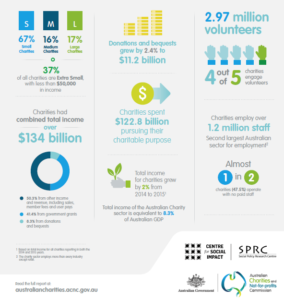
The ACNC Commissioner has released the ACNC’s Interpretation Statement on Public Benevolent Institutions. The purpose of the Commissioner’s Interpretation Statement is to provide guidance on the ACNC’s view on the meaning and scope of the charity subtype of ‘public benevolent institution’ (PBI) for ACNC purposes.
An entity that is a “registered PBI” will also be a “registered charity” and therefore may be eligible for the Commonwealth tax concessions which are available to registered charities.
The 3 essential elements of a PBI are: it must be ‘public’ in the required sense, benevolent and an institution.
A PBI must have benevolent relief as its main purpose, and that relief must be specifically targeted at people in need and provided to relieve the needs of those people.
Appendix A sets out scenarios illustrating how the ACNC will apply the Commissioner’s Interpretation Statement in practice.
How many charities are there?
The Australian Charities and Not-for-profits Commission (ACNC) has released its Australian Charities Report 2015.
The report summarises the size and shape of charities in Australia in pictures. Each page explores a different dimension including geography, sector & activity, finances, sustainability, change, people, age and entity type.
Over half of Charities are in the Religion, Education & Research or Social Service Sectors; the significant majority (83%) of Charities are medium or small.
In summary:
- number of charities: 50,908;
- total income: $134.5bn;
- total staff 122,676;
- estimated volunteers 2,966,157;
- charities with DGR status 38.4%;
- the largest 10% of the charities received 90% of the sector’s income.


